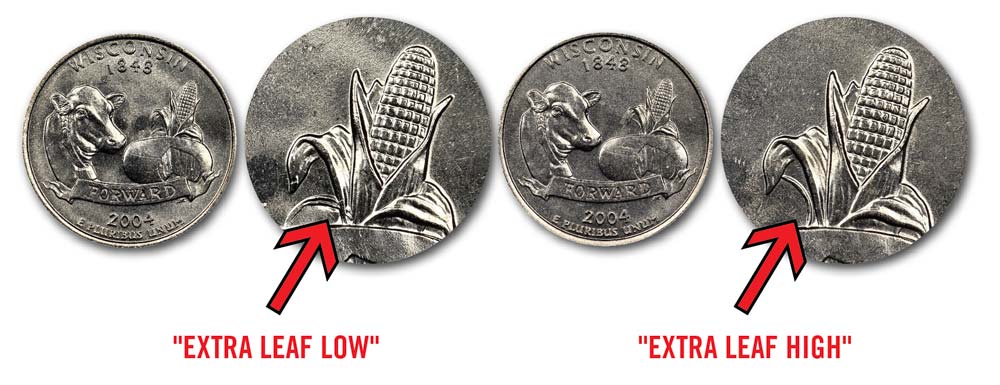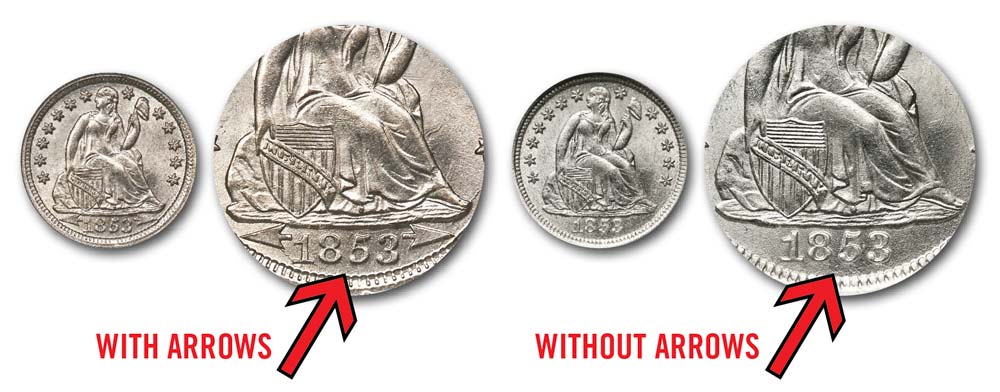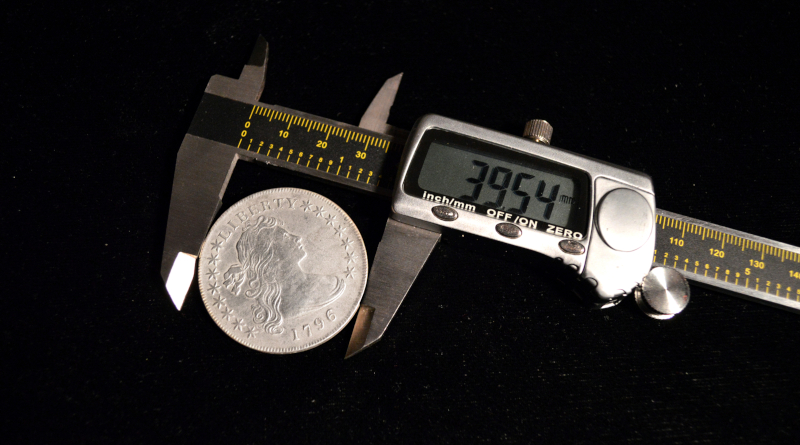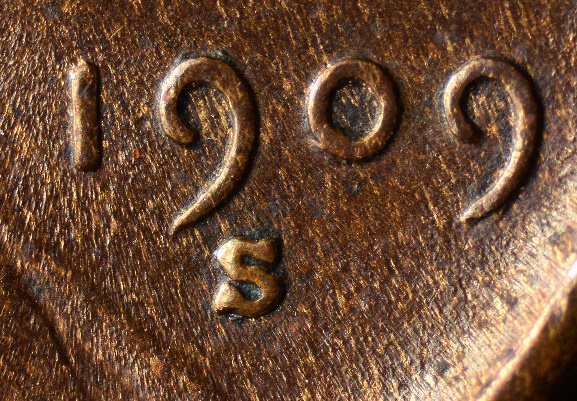Coin Varieties: the Spice of Your Collecting Life
A die variety occurs when there is an intentional or unintentional change or variation to the design on the coin die.
FOR SOME COIN COLLECTORS, when they get tired of collecting a particular series but would still like to pursue adding to their collection, focus on minor changes to the design of the coin and try to collect an example of each variety. Over the years, numismatists have performed intense research to document all the different varieties of a particular coin series. Collecting varieties can breathe new life into a collecting a series that you have already completed.
What Is a Variety?
A variety or die variety, as it is also called, occurs when there is an intentional or unintentional change or variation to the design on the coin die. Intentional changes to a coin design that affect the die are usually the result of correcting a problem in the minting process of the coin. If the intentional change occurs within a year, it is considered a variety.

The popular "3-Legged" Buffalo nickel is an example of a 'die wear' variety.
Examples of these intentional changes are:
Different styles of mintmarks occurring within the same year of a particular coin;
Minor changes in the design details, such as the size, style, and positioning of letters;
Minor variations in the position of mintmarks and dates.
Intentional changes to a coin's design that occur between years are usually referred to as "types." For example, the relief on the peace dollar was lowered after 1921 to help the design strike up easier. Therefore, the Peace Dollars of 1921 are referred to as "High Relief," and Peace Dollars in 1922 and later are referred to as "Low Relief."
Another example is Liberty Seated dimes, minted from 1837 through 1891, that have five different types. In 1838, they added stars to the obverse; in 1853, they added arrows next to the date; in 1860, they removed the stars and the arrows on the obverse and added a legend; in 1873, the arrows next to the date returned, and in 1875 they removed the errors again.
Variety Versus Mint Error
There is some debate about what constitutes a variety versus a mint error. Most numismatists agree that an error coin usually results from a mistake during the minting process. This could be caused by equipment malfunctions, human error, or other unintended mechanical processes. Mint errors are grouped into three categories: problems with the planchet, problems with the die, and problems with the striking of the coin.
Examples of mint errors are off-center strikes, double strikes, clipped planchets, wrong metal strikes, etc. Once detected, mint error coins are removed from the manufacturing process and destroyed. However, sometimes, they do escape the mint's quality control process and can be very valuable.
How They Are Created
The minting process at The United States Mint has dramatically changed since the mint opened in 1792. Originally, each and every die that was used to make coins was engraved by hand. Therefore, while the design of a particular coin may be identical, some details will be different from die to die.
As the minting process evolved, some automation and repetition tools were introduced. For example, some devices on the coins were added via custom-made tools. For example, a portrait of Lady Liberty may be punched into the die by hand. Additionally, lettering, numbers, stars, and other decorative devices were added by hand. Therefore, the position of these devices will vary from die to die.
To increase consistency and quality, the mint started using reduction lathes. In 1836, the mint started using pantograph reduction machines. The Janvier Reducing Machine was introduced in 1907 to reduce images from a Galvano and transfer them to master dies and master hubs. The U.S. Mint used a Janvier Reducing Machine until 2008, when it was replaced by CNC milling machines. However, the machine is occasionally used today in some places because of its accuracy.
Fast forward to the modern minting process of today, where dies and hubs are made by computer-controlled engraving machines. This ensures that each and every die is exactly identical. Additionally, the mint has developed a process where it only takes one squeeze to make a die from a hub. Improvements like this have all but eliminated doubled die varieties.

The well-known Wisconsin statehood quarter "High Leaf" and "Low Leaf" varieties are actually examples of a 'intentional alterations' by a US Mint employee.
Types of Varieties
Die varieties on coins arise from differences or changes in the dies used to strike coins. The possibility of different die varieties are endless. However, here are some common die varieties and how they are created:
Die Marriages: This refers to a specific pairing of an obverse die and a reverse die used to strike coins. Each die has unique characteristics, even if they are minor or subtle. When a specific obverse die is paired with a specific reverse die, the resulting coins struck by that combination form a distinct die marriage which can be distinctly identified.
Die Wear: Over time, dies used to strike coins can wear down, leading to softer details on coins. Mint employees may try to extend the life of the die by trying to repair it. This resulted in some well-known die varieties, such as the 1937-D Three-Legged Buffalo Nickel and the 1922 No D Lincoln Cent.
Repunched Mintmarks (RPM): Before mintmarks were added to the master die, each working die had to have the mintmark manually punched. Sometimes, the mintmark was not punched correctly the first time, leading the mint worker to punch it again. This can result in two mintmarks slightly offset from each other.
Overdates: These occur when an older or incorrect date on a die is overpunched with a newer one. This was more common in earlier periods when minting practices were less standardized, and dies were sometimes repurposed to save on costs.
Doubled Dies: This happens when a die receives an additional, misaligned impression from the hub (the original master design). Coins struck from double dies show a doubling of some or all design elements. One of the most famous U.S. coin varieties is the 1955 doubled die Lincoln cent.
Design Changes: Sometimes, a decision is made to slightly change the design of a coin partway through its mintage. Coins struck before and after the design change will show different varieties. For example, small changes in the positioning or style of letters, numbers, or other design elements can create distinct varieties.

The "With Arrows" and "Without Arrows" Liberty Seated dimes are excellent examples of 'design change' varieties.
Clash Dies: When the hammer die and the anvil die come together without a planchet in between, they can leave imprints of their designs on each other. Coins struck with these dies might show faint impressions of the opposite side's design in the wrong place. A famous example of this is the 1955 "Bugs Bunny" Franklin half-dollar (Fivaz-Stanton variety: FS-50-1955-401).
Intentional Alterations: On rare occasions, mint workers might intentionally alter a die, perhaps as a joke or for some other reason. The resulting coins will have features not found on the standard issues. For example, the 2004-D Wisconsin State Quarter has two varieties, the "Extra Leaf Low" and the "Extra Leaf High" variety.
Variety Catalogs
Over the years, numismatic researchers have spent countless hours cataloging the different varieties of United States coins. In order to create an index, they usually implemented a numbering system to make it easier to refer to the different varieties.
Although numbering systems will vary from catalog to catalog, they usually follow a format of letters and numbers. As additional varieties are discovered, letters or numbers may be added as a suffix to known varieties.
An example of the Fivaz-Stanton variety numbering system is FS-10-1928S-101 . The "FS" identifies it as a Fivaz-Stanton variety number, "10" is the denomination (dime), "1928S" is the year and the mintmark, and "101" identifies the particular variety as an obverse doubled die.
On the other hand, Leroy C. Van Allen and A. George Mallis just used a sequential numbering system to catalog die varieties on Morgan and Peace dollars. An example might be "1878-P VAM-14" for the fourteenth discovered variety (8TF Chip in Ear, Doubled Motto) for the 1878 Philadelphia minted Morgan dollar. As additional sub-varieties were discovered, a series of numbers and letters were added. For example: "1878-P VAM-14.2B" identifies the "8TF Polished Ear, Doubled Date, Tripled Left Stars, Feed Finger Gouges & Break OF" variety.
Here are some of the more popular variety catalogs for different types of United States coinage:
- Half Cents (1793–1857): Cohen numbers;
- Large Cents (1793–1814): Sheldon numbers;
- Large Cents (1816–1857): Newcomb numbers;
- Half Dimes (1794–1837): Logan/McCloskey numbers;
- Dimes (1796–1837): John Reich Society numbers;
- Quarter Dollars (1796–1838): Browning numbers;
- Half Dollars (1794–1836): Overton numbers;
- Morgan and Peace Dollars (1878–1935): VAM numbers (Leroy C. Van Allen and A. George Mallis);
- Half Cents through Quarters: Cherrypickers' Guide, Fivaz-Stanton Varieties. [Order here from Whitman]

Download the Greysheet app for access to pricing, news, events and your subscriptions.
Subscribe Now.

Subscribe to The Greysheet for the industry's most respected pricing and to read more articles just like this.
Author: James M Bucki
Related Stories (powered by Greysheet News)
View all news
There are many reasons people start collecting coins: for fun, profit, even investment. It's best to learn the basics before you jump in too quickly.

Detecting counterfeit coins is a science that requires skill and experience to perfect.

Being able to identify counterfeit and altered coins can save you hundreds, if not thousands, of dollars if you know how to do it well.









Please sign in or register to leave a comment.
Your identity will be restricted to first name/last initial, or a user ID you create.
Comment
Comments